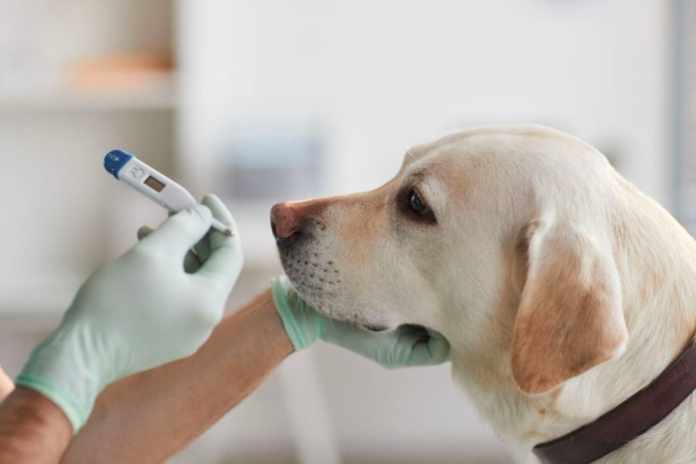Normal Dog Temperature: What You Need to Know. A responsible pet owner will take the time to understand their dog’s health and well-being. A good way to monitor your furry friend’s health is to be aware of their normal body temperature. The body temperature of a dog, like that of a human, is a reliable indicator of the overall health of the animal.
We will provide information about normal dog temperature, how to measure it accurately, signs of abnormal temperature, factors affecting temperature regulation, health conditions associated with temperature irregularities, and tips on maintaining a normal temperature for your dog.
Table of Contents
Understanding Body Temperature in Dogs
A dog’s normal body temperature typically ranges between 99.5°F and 102.5°F (37.5°C and 39.2°C). Nonetheless, it is important to keep in mind that a dog’s body temperature is affected by a variety of factors, including his breed, age, activity level, and the environment in which he lives.
The normal temperature of puppies and older dogs tends to be higher than that of smaller breeds, and the resting temperature of small breeds tends to be higher than that of larger breeds.
How to Measure a Dog’s Temperature?
A precise measurement of your dog’s temperature is essential to obtaining accurate information about its health. Using a digital thermometer to measure the rectal temperature is the most reliable method. To make the process more comfortable for your dog, make sure to lubricate the thermometer with petroleum jelly or water-based lubricant before measuring.
You should wait until the thermometer beeps or indicates that the measurement has been completed after gently inserting the thermometer into the dog’s rectum. The thermometer should be thoroughly cleaned before each use.
Signs of Abnormal Temperature in Dogs:
Dogs with abnormal body temperatures may have underlying health problems. When the body temperature falls below 99.5 degrees Fahrenheit (37.5 degrees Celsius), hypothermia may be characterized by shivering, lethargy, pale gums, and a weak pulse.
A hyperthermia is the opposite of hyperthermia, which is defined as a body temperature exceeding 102.5°F (39.2°C). Hyperthermia can cause excessive panting, drooling, vomiting, and even death. You should seek veterinary care immediately if you observe any signs of an abnormal temperature.
Factors Affecting Dog’s Temperature Regulation:
There are several factors that can influence how well a dog is able to regulate its body temperature under varying climate conditions. A small breed’s lower body temperature regulation may be due to its larger surface area-to-volume ratio. Because of this, small breeds may lose heat more quickly than larger breeds. It should be noted that certain breeds with thick coats or brachycephalic (short-nosed) breeds may have difficulty dissipating heat, making them more likely to overheat.
Dogs’ body temperature is also affected by their environment. Dogs can become hypothermic during cold weather if they are exposed to low temperatures for an extended period without adequate shelter or insulation. Hot weather and high humidity, on the other hand, can result in heatstroke in dogs, particularly if they are exposed to excessive heat or confined to an area that is poorly ventilated.
Temperature Irregularities and Health Conditions:
:strip_icc()/ViewStock-GettyImages-500826517-56a26bab5f9b58b7d0ca0ade.jpg)
A dog’s temperature irregularities may be indicative of underlying health conditions. Hypothermia can be caused by exposure to cold weather, prolonged anesthesia, certain medications, or underlying medical conditions, such as hypothyroidism or low blood sugar levels. Several factors can cause hyperthermia in dogs, including heatstroke, exertion in hot weather, infectious diseases, and conditions that impair the dog’s ability to disperse heat.
The temperatures of your dog should be checked by a veterinarian immediately if you suspect they are abnormal, as these conditions can have serious consequences for their health and well-being.
Tips for Maintaining a Dog’s Normal Temperature:
The following measures should be taken to ensure your dog’s body temperature stays within the normal range:
- Cold Weather:
-
-
- You should provide your dog with adequate shelters, such as an insulated and warm dog house, to ensure that he remains warm during the winter months.
- A blanket or bedding can provide your dog with a cozy and warm environment.
- A dog jacket or sweater may be necessary in extremely cold weather.
-
- Hot Weather:
-
- A hot car or poorly ventilated area may quickly lead to the development of heat stroke in your dog.
- Always ensure that fresh water is available during hot weather.
- You should avoid excessive exercise during hot weather and consider taking a walk at night when temperatures are cooler.
Conclusion:
A dog’s body temperature must be monitored as part of responsible pet ownership. Dogs’ ability to regulate their body temperature is affected by factors such as their breed, size, environment, and underlying health conditions. To ensure your dog’s well-being and overall health, ensure that your dog receives proper care, shelter, and veterinary attention as needed.
















